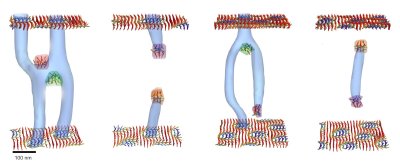Researchers from the University of Waterloo, NIST and McMaster University have used neutron imaging and a reconstruction algorithm to reveal for the first time the 3D shapes and dynamics of skyrmions in bulk materials.
The combined image reveals the shape and length of the skyrmion tubes, which vary in response to defects encountered in the surrounding material lattice. Credit: Phys.org, adapted from Nature Physics (2023)
The team is exploring a promising spintronic candidate, a magnetic skyrmion, which is a vortex-like formation of atoms. It arises naturally in certain kinds of atomic lattices in response to magnetic and electrical properties of the surrounding atoms. Skyrmions are typically in the range of 20 to 200 nanometers (billionths of a meter) in size.
In two dimensions, skyrmions take the shape of disks in which the atoms' individual magnetic fields point in different directions depending on their position on the disk—like the wind directions at different places in a tornado. But in bulk materials, skyrmions can stack up vertically, forming 3D tubes, the tops of which can extend to the top and bottom surfaces of the material. If the shape of each tube was the same, then an array of skyrmions could be used to store data and could be switched from one state to another by applying a faint magnetic or electric field, much as information is read or written on a hard-drive platter.
"But the tubes do not form consistent shapes", explained NIST team leader Michael Huber. "They curve, twist, bifurcate, or terminate because of defects and asymmetries in the surrounding lattice. We're trying to understand exactly what causes those effects, and how we can manipulate the material to control them."
For the study, first author Melissa Henderson of the University of Waterloo made bulk samples—cubes about 3mm on a side—containing 3D stacks or tubes of skyrmions in a lattice of cobalt, zinc, and manganese. They were brought to NIST for a novel form of neutron tomography, a process in which a beam of neutrons is directed at a sample. When the neutrons collide with different formations within the lattice—in this case, skyrmion tubes—they scatter off in different directions depending on the shape of the tubes at that point.
Each sample was placed in a magnetic field about the strength of a refrigerator magnet and rotated incrementally by very small angles, producing a series of "slices" that were then combined using a shape-reconstruction algorithm to make a single 3D image. The result showed how the shape and propagation of skyrmion tubes are linked to different kinds of imperfections in the surrounding lattice.
"In a perfect crystal, you'd have these perfect straight tubes that permeate surface to surface," Henderson said. "But we know as scientists that there's no perfect crystal and so at any given temperature, you're going to have some crystal and magnetic defects that are going to interrupt these tubes."
The researchers were able to determine how various sorts of localized defects in the lattice affected the shapes of the skyrmion tubes. "When we can get pure visualizations of these objects, and then we can change various parameters and understand how they respond," Henderson said, "we can use them to tune future materials for spintronics."
"It may sound somewhat exotic now," Huber added. "But 10 years from now, you'll go down to the electronics store and get a hard drive that is totally based on spintronic properties, with more densely packed storage and high efficiency.
"For that to happen, we have to understand features such as skyrmions, learn how to control them, and find the right materials."
